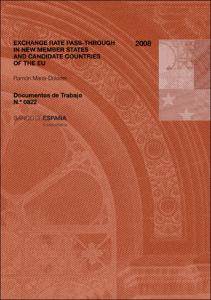Registro completo de metadatos
| Campo DC | Valor |
|---|---|
| dc.contributor.author | María-Dolores Pedrero, Ramón |
| dc.coverage.spatial | Países de la UE |
| dc.date.accessioned | 2019-08-10T17:52:56Z |
| dc.date.available | 2019-08-10T17:52:56Z |
| dc.date.issued | 2008-10-07 |
| dc.identifier.issn | ISSN: 0213-2710 (en papel) |
| dc.identifier.issn | ISSN: 1579-8666 (en línea) |
| dc.identifier.uri | https://repositorio.bde.es/handle/123456789/6953 |
| dc.description.abstract | This paper studies the pass-through of exchange rate changes into the prices of imports that originated inside the euro area made by some New Member States (NMSs) of the European Union and one candidate country (Turkey). I use data on import unit values for nine different product categories and bilateral imports from the euro area for each country and I estimate industry-specific rates of pass-through across and within countries using two different methodological approaches. The first one is based on Campa and González-Mínguez (2006) which estimates the short- and long-run pass through elasticities, where long-run elasticities are defined as the sum of the pass-through coefficients for the contemporaneous exchange rate and its first four lags. The second one is employed by de Bandt, Banerjee and Kozluk (2007) which suggests a long-run Engle and Granger (1987) cointegrating relationship and the possibility of structural breaks to restore the long-run in the estimation. I did not find evidence either in favour of the hypothesis of Local Currency Pricing (zero pass-through) or the hypothesis of Producer Currency Pricing (complete pass-through) for all the countries except Slovenia and Cyprus in the latter. The exchange rate pass-through ranged from 0.090 to 2.916 in the short-run and from 0.102 to 2.242 in the long-run. With reference to the results by industry the lowest values for exchange rate pass-through are in Manufacturing sectors. However, I did observe a exchange rate pass-through decline through the pricing chain and a large dependence of their economies on imported inputs |
| dc.format.extent | 52 p. : tab. |
| dc.language.iso | en |
| dc.publisher | Banco de España |
| dc.relation.ispartof | Documentos de Trabajo / Banco de España, 0822 |
| dc.rights | Reconocimiento-NoComercial-CompartirIgual 4.0 Internacional (CC BY-NC-SA 4.0) |
| dc.rights | In Copyright - Non Commercial Use Permitted |
| dc.rights.uri | https://creativecommons.org/licenses/by-nc-sa/4.0/deed.es_ES |
| dc.rights.uri | http://rightsstatements.org/vocab/InC-NC/1.0/ |
| dc.subject | Echange rates |
| dc.subject | Pass-through |
| dc.subject | Monetary union |
| dc.subject | Panel cointegration |
| dc.title | Exchange rate pass-through in new member states and candidate countries of the EU |
| dc.type | Documento de trabajo |
| dc.identifier.bdebib | 000215864 |
| dc.identifier.bdepub | DTRA-200822-eng |
| dc.subject.bde | Finanzas internacionales |
| dc.subject.bde | Modelos econométricos |
| dc.subject.bde | Integración monetaria europea |
| dc.subject.bde | Economía internacional |
| dc.publisher.bde | Madrid : Banco de España, 2008 |
| dc.subject.jel | F31 |
| dc.subject.jel | F36 |
| dc.subject.jel | F42 |
| dc.subject.jel | C23 |












